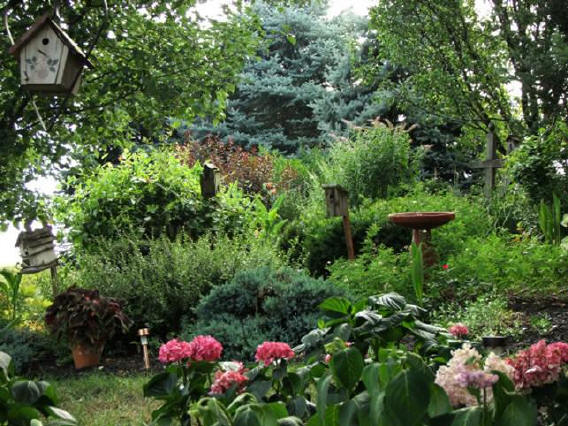 Bird gardening is the art of creating a habitat to attract birds by planting trees, shrubs, and flowers on your property. Creating a
sustainable bird sanctuary makes the landscape look beautiful and also attracts birds to your backyard throughout the four seasons. Making an effort to restore the ecology of your own gardens, while creating a useful habitat
for birds, is an excellent way to improve your property and the environment.
Bird gardening is the art of creating a habitat to attract birds by planting trees, shrubs, and flowers on your property. Creating a
sustainable bird sanctuary makes the landscape look beautiful and also attracts birds to your backyard throughout the four seasons. Making an effort to restore the ecology of your own gardens, while creating a useful habitat
for birds, is an excellent way to improve your property and the environment.
Before digging into creating a bird sanctuary, analyze the location you have selected on your property and determine how much space you want to reserve for your bird sanctuary. Be sure that the
location is within viewing distance of the confines of your home so that you can enjoy the pleasure of bird-watching. If possible, be prepared to expand your bird garden. It will become such an exciting project that you will
want to create additional habitat for your pleasure and that of the birds. My bird garden started out to be a very small area and within a few years, it has extended to almost ¼ acre in circumference. Keep in mind that a
natural-looking space is more attractive to birds than a well-manicured yard.
Four main things that birds need for their environment are food, water, nesting spots, and shelter. All species of birds need water for drinking and bathing throughout the year. Preserving an area of
open water for birds is one of the most useful tools for attracting birds to the backyard. This can be as simple as a freshly filled bird bath or as elaborate as a water garden or small pond. The water source should be
located at an area where the birds can safely get to it for drinking purposes and there should be a shallow area for the birds to bathe.

Include different types of plant food in your bird sanctuary. Grow flowers for nectar and seeds, grasses for shelter, and shrubs and trees for food, nesting, and shelter. Plants that hold their fruits
through the winter provide a vital food source for non-migratory birds. Whenever possible, encourage native plants, as their seeds are the natural food for native birds. If there is a shortage of food, you can hang up bird
feeders. Add variety to the kinds of food you offer, and you will attract a wider variety of bird species.
Cotoneaster, elderberry, holly, spirea, and honeysuckle are excellent choices of shrubs and vines for your bird sanctuary. Evergreens will provide birds with shelter both winter and summer. Dense
evergreens provide good cover for birds during heavy snowfalls. Pine cones provide food for species such as chickadees and finches. Some other trees that birds enjoy for food and shelter are mulberries, dogwoods, crab
apples, mountain ash, and serviceberries. Hang a few birdhouses in your trees or on a fence post to encourage nesting.
Sunflowers, goldenrod, tickseed, hollyhock, larkspur, and coneflowers are great plants to include in a bird-friendly garden. As these plants go to seed, finches, juncos, sparrows and goldfinches will
be attracted. Hummingbirds are attracted to bold, colorful plants, especially red ones. They prefer bell or trumpet-shaped flowers. The most popular flowers in my garden for hummingbirds are honeysuckle, summer phlox,
bleeding heart, hibiscus, mandevilla, and canna lilies. Also hang a hummingbird feeder near your windows so that you can enjoy their antics. The hummingbirds will feed at the feeder when there are not flowers for them as a
food source. When it is raining, they prefer to get their nourishment from the feeder instead of the flowers.
Some of the birds that are attracted to our bird garden are the blue jay, cardinal, goldfinch, cowbird, house finch, purple finch, house wren, Carolina wren, brown thrasher, catbird, pinesiskin,
yellow warbler, ruby-crown kinglet, cedar waxwing, hummingbird, mockingbird, chickadee, junco, downy woodpecker, red-breasted woodpecker, white breasted nuthatch, and tufted titmouse. I have found that spending time in a
garden full of birds is the ultimate therapy. It calms my mind, erases the everyday concerns, and the busyness of my life for a few hours.
It is not too difficult to create a bird-friendly garden. Designing a garden for birds is an investment that will last a lifetime. Bringing the pleasures of plants and the lively antics of birds to
your backyard will give you new surprises every day!
Read other articles on birds, wildlife & beneficial insects
Read other articles by Carolyn Black